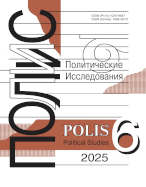Some macrostructure changes in the world politics. Trends for 2020 2030s
Kokoshin A.A.,
Dr. Sci. (Hist.), Professor, Member of the Russian Academy of Sciences, member of the Russian Academy of Rocket and Artillery Sciences, Dean of the School of World Politics, Lomonosov Moscow State University, from-kokoshin@yandex.ru
elibrary_id: 77052 |
DOI: 10.17976/jpps/2014.04.04
Kokoshin A.A. Some macrostructure changes in the world politics. Trends for 2020 2030s . – Polis. Political Studies. 2014. No. 4. https://doi.org/10.17976/jpps/2014.04.04
In the author’s perspective, the mounting macro-transformation of the world politics system is primarily connected with the new global role of its subjects, the states (or nation-states). Significance of non-governmental actors has grown, but it has not yet reached the level that would allow them to overshadow the role of the main structural elements of world politics, the states. Fundamentally, it is cyber-states that have become new arena for the state and non-state actors of the world politics, as the author believes. It is today an integral part, a very specific field of activity and the environment, which reveals relatively autonomous character. “Center of gravity” of the global most noticeable shifts to the Asia-Pacific Region (APR), where the “locomotive” of changes has primarily become China. The author analyzes in detail the main directions of development of China in the spheres of economy, politics, and security. Within the next few decades, among China’s most serious claims is a claim to become the “second superpower” of the world politics. Having gained considerable economic power, and modern well-equipped armed forces deriving from this power, China resolutely asserts its international role in priority areas. The author believes that after the 1990s – a period of open domination of the United States in the world economy and global politics – the U.S.A.’ position as the sole superpower demonstrates the trend towards erosion. Against this background, among Russia’s core interests are high growth rates of its national economy, primarily stemming from a radical structural change in favor of the development of knowledge-intensive, high-tech industries. The researcher concludes that the Russia’s role in the global economy, in the bodies of “global governance” starting with G20, in the medium and long term, will be largely determined by the degree of success for the development of reintegration processes within the CIS.
See also:
Alekseyeva T.A.,
Reflections on modern world politics. – Polis. Political Studies. 2010. No3
Khatuntzev S.V.,
The West and the “Eurasian Quadriga” (Russia, China, India, Iran). – Polis. Political Studies. 2015. No6
Chugrov S.V.,
Moscow University Bulletin. Series 25. International relations and world politics: 5 years on track. – Polis. Political Studies. 2014. No5
Bogaturov A.D.,
The Chinese Angle in the World-system Management. – Polis. Political Studies. 2019. No5
Tretyakov V.T.,
The U.S. and Russia under Trump and Putin: One Against the Other, Apart, or Together?. – Polis. Political Studies. 2017. No6




.jpg)






 print
print
.jpg)
.jpg)